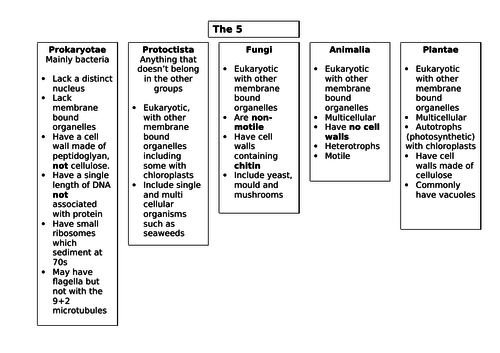













WORKSHEETS ONLY FOR LESSONS SEE:
KS3 Unit 8D Biology - Cells, fungi and the carbon cycle
Aimed for High-Middle ability Year 8 but can be adapted for low/middle ability if required (Higher and lower slides)
Further to this the lessons can also be split into two for each section - but due to time constraints and a very high ability class I was able to get through it all in 7 lessons rather than 8 lessons
Lesson 8Da: Unicellular or multicellular
Lesson 1- Unicellular and Multicellular organisms
To state the meaning of the terms unicellular and multicellular
To be able to explain the transport systems in unicellular organisms
To explain the transport systems in multicellular organisms
Lesson 2 - The 5 Kingdoms
To recall the five kingdoms of organisms
To use the key characteristics of microorganism cell structure to classify microorganisms
To justify the lack of a virus kingdom
Lesson 8Db: Microscopic fungi
Lesson 3 - Yeast and baking bread
To identify and state the functions of common parts of a yeast cell
To be able to investigate the conditions under which yeast grows quickly
To evaluate the experiment
Lesson 4 - Yeast, alcohol production and Growth curves
To explain what happens in fermentation
To explain what is happening in the different parts of a growth curve
To use graphs to calculate population growth rates
Lesson 8Dd: Protoctists
Lesson 5 - Photosynthesis
To recap how to label a plant cell
To describe, identify and state the parts of protoctist cells
To describe what happens in photosynthesis
Lesson 6 - Eutrophication
To explain how eutrophication occurs and the problems associated
To be able to define feeding relationships in terms of energy flow
To explain how changes in physical environment affect the distribution of organisms
Lesson 8De: Decomposers and carbon cycle
Lesson 7 - Decomposers
Lesson 8- Carbon cycle
To state the names of the compounds in which carbon is held in an ecosystem
To be able to explain the importance of decomposers in an ecosystem
To model the recycling of carbon in an ecosystem using the carbon cycle
7 lessons including practicals
(can be split to 8 if required)
Targeted towards specification
All extension questions available on each slide
Answers all underneath each slide
Support also available where necessary
AfL sections and mini quizzes
Reducing the need for photocopying
Enjoy !!!
PLEASE LEAVE FEEDBACK and REVIEWS
Something went wrong, please try again later.
Report this resourceto let us know if it violates our terms and conditions.
Our customer service team will review your report and will be in touch.
